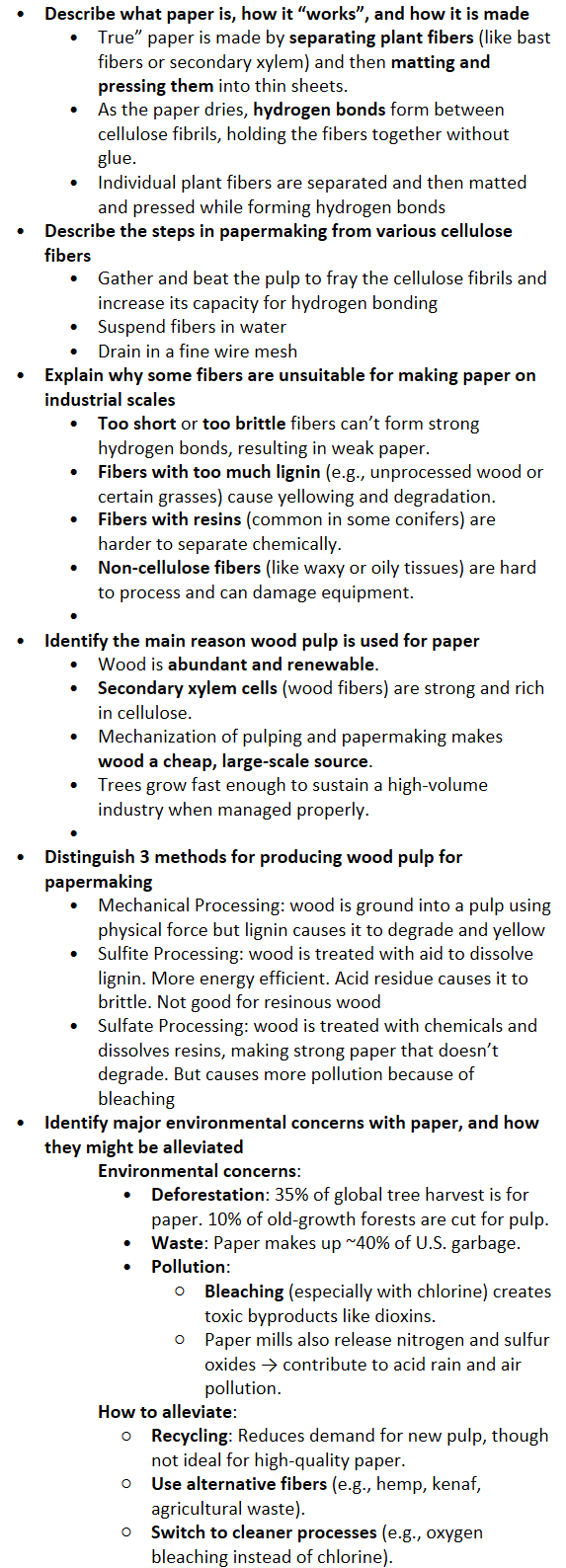13 Paper
Describe what paper is, how it “works”, and how it is made
True” paper is made by separating plant fibers (like bast fibers or secondary xylem) and then matting and pressing them into thin sheets.
As the paper dries, hydrogen bonds form between cellulose fibrils, holding the fibers together without glue.
Individual plant fibers are separated and then matted and pressed while forming hydrogen bonds
Describe the steps in papermaking from various cellulose fibers
Gather and beat the pulp to fray the cellulose fibrils and increase its capacity for hydrogen bonding
Suspend fibers in water
Drain in a fine wire mesh
Explain why some fibers are unsuitable for making paper on industrial scales
Too short or too brittle fibers can’t form strong hydrogen bonds, resulting in weak paper.
Fibers with too much lignin (e.g., unprocessed wood or certain grasses) cause yellowing and degradation.
Fibers with resins (common in some conifers) are harder to separate chemically.
Non-cellulose fibers (like waxy or oily tissues) are hard to process and can damage equipment.
Identify the main reason wood pulp is used for paper
Wood is abundant and renewable.
Secondary xylem cells (wood fibers) are strong and rich in cellulose.
Mechanization of pulping and papermaking makes wood a cheap, large-scale source.
Trees grow fast enough to sustain a high-volume industry when managed properly.
Distinguish 3 methods for producing wood pulp for papermaking
Mechanical Processing: wood is ground into a pulp using physical force but lignin causes it to degrade and yellow
Sulfite Processing: wood is treated with aid to dissolve lignin. More energy efficient. Acid residue causes it to brittle. Not good for resinous wood
Sulfate Processing: wood is treated with chemicals and dissolves resins, making strong paper that doesn’t degrade. But causes more pollution because of bleaching
Identify major environmental concerns with paper, and how they might be alleviated
Environmental concerns:
Deforestation: 35% of global tree harvest is for paper. 10% of old-growth forests are cut for pulp.
Waste: Paper makes up ~40% of U.S. garbage.
Pollution:
Bleaching (especially with chlorine) creates toxic byproducts like dioxins.
Paper mills also release nitrogen and sulfur oxides → contribute to acid rain and air pollution.
How to alleviate:
Recycling: Reduces demand for new pulp, though not ideal for high-quality paper.
Use alternative fibers (e.g., hemp, kenaf, agricultural waste).
Switch to cleaner processes (e.g., oxygen bleaching instead of chlorine).
